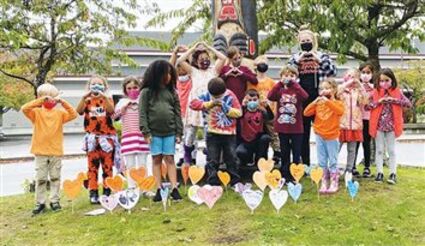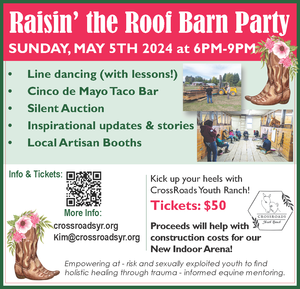Orange Shirt Day recognized on La Conner campus
October 6, 2021

LA CONNER SCHOOLS STUDENT AND STAFF REACH OUT ACROSS SPACE AND TIME – At last Thursday’s Orange Shirt-Residential School Awareness Day the entire campus gathered on the football field for a districtwide photo. Before that these elementary school children made and showed that they had hearts and empathy for children, like them, who never returned home to their families – Photo by Ken Stern
Two weeks after approving a new labor contract with the La Conner Education Association, La Conner School District board members rolled up their sleeves and got to work on several key tasks marking the start of the 2021-22 academic year.
The first of those at their Sept. 27 meeting was to unanimously approve a proclamation designating Sept. 30 as Orange Shirt-Residential School Awareness Day during their 90-minute hybrid public session.
The board action followed a presentation by district community and cultural liaison Clarissa James, who said the proclamation is designed in part to address historic trauma rooted in atrocities resulting from decades of indigenous students being forced to attend and undergo assimilation at boarding schools.
“It is a difficult topic to discuss,” said James, who noted, however, that doing so in a positive and productive manner can help bring healing to those impacted by the residential school experience.
“It’s important for educators to understand that the effects are still present with our students today,” she said.
James was hopeful Sept. 30 will be recognized each year as Orange Shirt-Residential School Awareness Day. That date was selected, she said, because September is the time of year when buses traditionally carried indigenous students from their homes to what she termed their “new harsh realities.”
James credited Phyllis Webstad of the Dog Creek Reserve in British Columbia with launching the movement. She said orange was selected as the color to symbolize the event based on a traumatic episode from Webstad’s childhood.
According to James, upon Webstad’s arrival at a residential school she was stripped of a favorite orange shirt she had worn to that campus.
Board members thanked James.
“Thank you for bringing this forward,” said J.J. Wilbur, who also serves on the Swinomish Indian Tribal Community Senate. “Most of my great-grandparents were forced into those schools. There’s historical trauma that’s the result of this and it’s something we need to recognize.”
Coincidentally, it is a La Conner High School graduate, Dr. Kisha Supernant, an archaeologist at the University of Alberta, who has taken a lead role in the search for unmarked graves of students who attended residential schools in Canada.
The board also passed a formal resolution at the behest of Swinomish leadership and in accordance with a new state law, that retains the Braves team name for La Conner Schools while putting in motion a plan to develop a new mascot logo appropriate to Coast Salish culture.
The school district has received an inventory of existing images on campuses here that have either been approved or disapproved by the Swinomish Tribe for continued use. A new logo must be chosen prior to Dec. 31 and images depicting Native American culture that are deemed inappropriate – such as the Plains Indians headdresses – are to be phased out, said Superintendent Will Nelson, a member of the Blackfeet Indian Nation.
As part of the process, the district will conduct a survey and initiate an art contest to create a new logo.
Wilbur, who abstained from voting on the resolution, praised last year’s interim superintendent Rich Stewart for having initiated dialogue with Swinomish following the overwhelming passage of Native American mascot legislation sponsored by Rep. Debra Lekanoff, D.-Bow, earlier this year.
“I want to thank Rich Stewart for discussing these important matters with the Tribal Senate,” Wilbur said.
The board also approved a contract with Northwest Educational Services District 189 providing training regarding student threat assessments.
Students across grade levels made presentations on behalf of the district’s Highly Capable academic program (H-CAP), which provides participants meaningful and challenging scholastic opportunities.
“It really helped me,” said sophomore Samuel Williams. “H-CAP allowed me to do math at my level. I like doing things that give me a challenge.”
High school senior Juna Swanson echoed that sentiment, recalling her participation in H-CAP from fourth through eighth grade.
“It was my favorite part of those years,” she said. “I was with people that I could connect with on an academic level.”











Reader Comments(0)